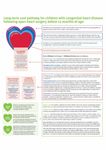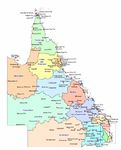Supporting the long-term developmental needs of children with congenital heart disease and their families
←
→
Page content transcription
If your browser does not render page correctly, please read the page content below
Queensland Health
Supporting the long-term developmental
needs of children with congenital heart disease
and their families
A companion document to ‘Understanding the Development and
Participation of Children with Significant Health Needs’
A service translation initiative delivered in partnership by the Queensland Paediatric Cardiac Service (QPCS)
and Queensland Child and Youth Clinical Network (QCYCN) 2016 - 2018
Clinical Excellence Division
Creating solutions for better healthcareSupporting the long-term developmental needs of children with congenital heart disease and their families. Published by the State of Queensland (Queensland Health), June 2018 This document is licensed under a Creative Commons Attribution 3.0 Australia licence. To view a copy of this licence, visit creativecommons.org/licenses/by/3.0/au © State of Queensland (Queensland Health) 2018 You are free to copy, communicate and adapt the work, as long as you attribute the State of Queensland (Queensland Health). For more information contact: CHD LIFE Program, Queensland Paediatric Cardiac Service, Children’s Health Queensland Email: CHQ_QPCS_CHDLIFE@health.qld.gov.au, phone: (07) 3068 5812 Queensland Child and Youth Clinical Network, Department of Health Email: Statewide_Child_And_Youth_Network@health.qld.gov.au, phone: (07) 3069 7227 An electronic version of this document is available at https://www.childrens.health.qld.gov.au/chq/ health-professionals/qcyc-network/ Disclaimer: The content presented in this publication is distributed by the Queensland Government as an information source only. The State of Queensland makes no statements, representations or warranties about the accuracy, completeness or reliability of any information contained in this publication. The State of Queensland disclaims all responsibility and all liability (including without limitation for liability in negligence) for all expenses, losses, damages and costs you might incur as a result of the information being inaccurate or incomplete in any way and for any reason reliance was placed on such information.
Acknowledgements
First and foremost, we extend our appreciation and gratitude to the parents and caregivers statewide
who contributed to this project, with special mention to our consumer representatives. They generously
shared their time, experience and valuable learnings of navigating the health care system to help us
understand their journeys and the lived experience of families of children with congenital heart disease.
They bravely shared the challenges and frustrations of accessing developmental services and supports
for their children, while showing humility and appreciation of the support they have received in order to
help future families. For this we are very grateful.
This project was conducted across three pilot Hospital and Health Services (HHS) and would not have
been possible without the dedication of the leads and stakeholders from health services within CHQ
Metro, Cairns and Hinterland and West Moreton HHSs, as well as the support from the respective Chief
Executives.
The steering committee, sponsored by Children’s Health Queensland (CHQ) executive, included
representation from each of the pilot HHSs, as well as the Queensland Child and Youth Clinical Network
(QCYCN), Child Development Subnetwork (CDSN), Queensland Paediatric Cardiac Service (QPCS),
Congenital Heart Disease Long-term Improvements in Functional hEalth (CHD LIFE) Program, GP Liaison/
Integrated Care Team, Innovation Change and Redesign Excellence (iCARE) program, HeartKids and
consumers. The committee’s guidance, commitment and belief in the work enabled project outcomes
to be realised. With the committee’s support, the project team worked tirelessly to maintain the energy,
progress the work, seek avenues for sharing the learnings and outcomes and harness opportunities
for ongoing work. The project team’s dedication, passion and desire to “dream big” realised project
outcomes far beyond those initially anticipated.
Finally, this project would not have been possible without the funding support provided by the
Healthcare Improvement Unit (HIU) through the Clinical Excellence Division, Queensland Health.
Miranda Campbell
Principal Project Officer (on behalf of the steering committee)
Supporting the long-term developmental needs of children with congenital heart disease 1Dedication This book is dedicated to the infants, children and young adults living with CHD. Your strength, courage and integrity inspire us to continue to improve health and developmental services, to support you to develop, participate and achieve to the best of your ability. 2 Supporting the long-term developmental needs of children with congenital heart disease
Foreword
A word from the Executive Sponsor
It has been a privilege to be Executive sponsor and to be part of ‘At the Heart of the Matter’ the
joint Children’s Health Queensland - Paediatric Cardiac Service (QPCS) and Queensland Child and
Youth Clinical Network (QCYCN), service quality and redesign initiative. This piece of work has been
underpinned by a shared vision, common understanding and a set of shared ‘can do’ values which have
been brought to life through a commitment to working in partnership. I want to pay tribute to everyone
involved, including the Queensland Department of Health – Clinical Excellence Division, Health
Improvement Unit who have provided financial assistance and in particular to clinicians, consumers and
families who have shared their expertise and experiences with the aim of improving the system of care
for others yet to come. Health system change can be challenging, however, we know from our recent
experience that with thoughtful reflection, a consumer focus, a commitment to partnering and a passion
for doing the right thing much can be achieved. ‘At the Heart of the Matter’ is a perfect example of how
we can deliver on promise when these core elements are recognised, harnessed and focused.
I trust you enjoy reading this report and find our learning helpful in informing your own improvement
and redesign initiatives. I look forward to seeing this work implemented across the State of Queensland
and to hearing how it contributes to improving the lives of children and families who have contact with
our health system.
Frank Tracey
Executive Director, Clinical Services, Children’s Health Queensland
Partnerships supporting statewide work
The QPCS and QCYCN partnered to progress the ‘At the Heart of the Matter’ project, a service translation
initiative to improve the neurodevelopmental care and ultimately quality of life outcomes for children
having cardiac surgery before 12 months of age. This partnership married the clinical expertise of our
cardiac surgeons, cardiologists, intensive care physicians, nurses and allied health clinicians, child
development experts, paediatricians, primary care experts, community partners and consumers, with
a statewide reach driven by the needs of children, families and young people themselves. We have all
learnt a great deal together that will feed system change through building knowledge, understanding,
linkages and pathways. It is the passion of the collective, our families and clinical champions that has
driven this work through inevitable challenges to deliver what ultimately has been a labour of love, ‘At
the Heart of the Matter’.
Associate Prof Dr Robert Justo
Director Cardiology, Queensland Paediatric Cardiac Service
Dr Kerri-Lyn Webb
Co-Chair Queensland Child and Youth Clinical Network
Supporting the long-term developmental needs of children with congenital heart disease 3CHD LIFE program evolution When the QPCS established what is now the CHD LIFE (Long-term Improvement in Functional hEalth) Neurodevelopmental Long-term Follow up Program in partnership with the Child Development Service in 2013, our mission was clear - to improve the long-term outcomes of children with congenital heart disease at risk of adverse outcomes and their families by screening for deviations, diagnosing impairments, raising awareness, facilitating early intervention, conducting research and training professionals. ‘At the Heart of the Matter’ has enabled us to expand our partnerships with clinicians, services and families and improve our understanding of the lived experience of congenital heart disease, what is important to families and what is possible when we come together with a focused vision. CHD LIFE Program is committed to continue this work into the future, to share our experience and contribute to the broader body of knowledge to improve the lives of those living with CHD in and beyond our care. Karen Eagleson Clinical Nurse Consultant - Cardiac Maternal Fetal Medicine/CHD LIFE Program HeartKids partnership, project and beyond HeartKids is the only national charity dedicated to supporting Australians of all ages impacted by congenital/childhood heart disease, the leading cause of infant death in Australia and a complex chronic disease requiring lifelong treatment. For over forty years, HeartKids has provided timely support to infants, young people and adults living with congenital/childhood heart disease all across Australia. We also fund life-saving research, provide reliable and evidence-based information and advocate for the needs of impacted families. Our support is a commitment for life. We are proud to have been involved in ‘At the Heart of the Matter’ a project that was outcome focused and demonstrates real impact for our families and for the community. One of the specific aims of the HeartKids research program has been to gain a better understanding of the consequences of CHD and its treatment including the neurological, cognitive or social impacts on children affected by CHD and how these issues are addressed. ‘At the Heart of the Matter’ has enabled HeartKids to play an active role in delivering on our aim. We are excited to extend our partnership to the CHD LIFE Program and continue to advocate for the needs of people impacted by CHD, provide quality information to guide families through their life long journey and deliver high quality support services. Holly Williams HeartKids Limited – QLD State Manager Integrating care for all children ‘At the Heart of the Matter’ is an important integrated care initiative which will benefit all children at increased risk of adverse neurodevelopmental outcomes. The issues identified and solutions developed are applicable beyond children who undergo early cardiac surgery, and will inform the care of many other groups of children requiring long-term surveillance and transition to adult care. It is my hope that the principles of coordinated, collaborative care articulated in this document become the norm in the care of all children and families. Dr Dana Newcomb Medical Director Integrated Care, Children’s Health Queensland Hospital and Health Service 4 Supporting the long-term developmental needs of children with congenital heart disease
Harnessing the voice of consumers
I can’t believe that I have been a part of something that is going to make such a huge difference for
families going forward and I’m proud of what we’ve contributed. I firmly believe that the solutions and
outcomes are going to make a massive difference for families in the future. I am also truly grateful for
the new friendships that I’ve formed. I’ve learnt so much along the way, especially how powerful and
important collaborative relationships are. I’ve also been quite blown away by how many people are so
passionate about their work. It’s so encouraging to see how this achieves great outcomes but also a
greater understanding for all involved.
Pam
Project consumer
Being part of the team who co-designed this valuable book was an opportunity I felt so passionately
about. Having “lived” the experience, I had the knowledge and understanding that could help others. It
was my way of helping other families better navigate the system in the community and in the hospital,
understand the jargon and help the services see the perspective of a family living and breathing
the journey. I found the experience extremely rewarding. The team was well led by someone just as
passionate about gaining positive outcomes.
Karen
Project consumer
Image supplied by HeartKids Limited.
Supporting the long-term developmental needs of children with congenital heart disease 5Table of contents
Document overview 8
What is the purpose of this document? 8
How should services use this document? 8
What’s included in this document? 8
Executive summary 10
Background 10
Project aims 10
Method 10
Project scope and limitations 11
Summary of issues with accessing developmental supports 11
Summary of solutions to improve access along the care continuum 12
Localisation and implementation of project solution strategies 12
Project outcomes 12
Future recommendations 13
Part one: Long-term care pathway 15
Part two: ‘At the Heart of the Matter’ service translation initiative 18
Chapter 1 Introduction 18
Background
Project aims 18
Method 19
Project scope and limitations 22
Chapter 2 Establishing the problem – summary of issues identified with accessing developmental
supports along the care continuum 25
Theme 1: Service provision throughout the child’s journey 25
Theme 2: Caregiver knowledge and skills 31
Theme 3: Patient and family centred care 32
Chapter 3 Identifying the solution - developing a statewide approach to the developmental
support needs of children with congenital heart disease in Queensland 34
Implement processes to support early neurodevelopment, from diagnosis
throughout inpatient admission 34
Provide caregivers with education, training, information and resources along
the care continuum to prepare them and support their involvement in care 35
Keep parent-infant mental health and caregiver wellbeing on the
neurodevelopmental agenda 35
Implement processes that support co-ordinated discharge and referral 35
Develop an integrated long-term care pathway, contextualised to each trial site,
to support the needs of each infant/family 36
CHD LIFE program will lead statewide education and training utilising existing
platforms and networks 36
6 Supporting the long-term developmental needs of children with congenital heart diseaseChapter 4 Statewide implementation 37
Chapter 5 Summary and conclusions 38
Chapter 6 Recommendations for the future 39
Achieving statewide implementation of project outcomes through partnerships 39
Recommendations for ongoing work 39
Transferability to other high risk cohorts 39
Part three: Literature review 41
Introduction 41
Definition and prevalence 42
Risk factors for poor developmental outcomes 42
Neurodevelopmental outcomes 44
Measuring long-term functional health outcomes 47
Support needs for children and families – the role of health services across
the care continuum 49
Chapter references 51
Appendices 56
Appendix 1: Abbreviations and definitions 56
Appendix 2: ‘At the Heart of the Matter’: Governance structure 58
Appendix 3: GP survey 59
Appendix 4: Parent survey 60
Appendix 5: Personal Health Record supports 66
Appendix 6: GP HealthPathways 67
Appendix 7: CHD LIFE database - Minimum dataset 68
Appendix 8: Example of contextualisation of care pathway in Cairns HHS 71
Supporting the long-term developmental needs of children with congenital heart disease 7Document purpose
What is the purpose of this document?
The purpose of this document is to assist services providing developmental supports to children and
families across the care continuum, to contextualise project outcomes to services within their hospital
and health service.
How should services use this document?
Services are encouraged to use this document to:
•• Understand the expected long-term developmental outcomes for children with congenital heart
disease who undergo open heart surgery before 12 months of age.
•• Understand the issues faced by children and families accessing developmental supports along
the care and developmental continuum across Queensland.
•• Understand how international best practice guidelines have been contextualised to the
Queensland health care system.
•• Localise the recommended long-term care pathway, to assist families to access the right services,
in the right place, at the right time.
What’s included in this document?
•• An executive summary providing a concise overview of this service translation initiative.
•• The recommended long-term care pathway, including an example of how this has been
contextualised to Cairns and Hinterland HHS to assist other HHSs to localise the pathway within
their service models.
•• A snapshot of key points at the beginning of each section.
•• A comprehensive literature review in Part 3, for services interested in understanding the
developmental outcomes of this high-risk population in more depth.
8 Supporting the long-term developmental needs of children with congenital heart diseaseExecutive summary Supporting the long-term developmental needs of children with congenital heart disease 9
Executive summary Background Congenital heart disease (CHD) is one of the most common birth defects and is the biggest single cause of child mortality and early childhood hospitalisation. In Australia, the prevalence of CHD is 7.8 cases per 1,000 births. Nearly one third of infants with CHD require surgical intervention. As surgical interventions are improving, mortality rates have significantly decreased. Children with CHD are surviving, but many are left with substantial physical, intellectual, psychological and social difficulties, leading to an increased burden upon families, health care systems and educational facilities. These difficulties can be very subtle in young infants and the extent of impairment can be overlooked or not fully recognised until more complex developmental skills are expected, such as at entry to formal schooling. Prior to this project, there was no reliable model of care to meet the neurodevelopmental needs of all children with CHD who undergo open heart surgery before 12 months of age in Queensland. The Queensland Paediatric Cardiac Service (QPCS) CHD LIFE (Long-term Improvements in Functional hEalth) Program provided robust developmental surveillance based on international best practice guidelines to a select high risk group of infants. However, it was centralised at Lady Cilento Children’s Hospital (LCCH) and did not include neurodevelopmental follow up to all infants undergoing surgery before 12 months as recommended. It is widely reported that an absence of early monitoring of neurodevelopment can delay identification of developmental concerns or even developmental disability, which in turn may delay access to early supports or intervention and limit children from achieving their full potential. The American Heart Association (AHA) recommends developmental surveillance of all children with CHD, including those who have undergone open heart surgery. These children will likely require access to support, from screening and developmental enrichment, through to specialist intervention. To address the disparity in statewide service provision and ensure best practice implementation, the QPCS partnered with the Queensland Child and Youth Clinical Network (QCYCN) to undertake a service translation initiative, to establish a statewide approach to the developmental support needs of children with CHD in Queensland. Service redesign methodology support was provided through a partnership with Children’s Health Queensland’s Innovation Change and Redesign Excellence (iCARE) Program. Project aims The primary aim of the project is that the developmental support needs of children with congenital heart disease and their families, provided by Queensland Health services across the care continuum within Brisbane Metro, West Moreton and Cairns and Hinterland regions, will be met by the right people, at the right time, in the right place. Method This service translation initiative utilised a clinical service redesign (CSR) methodology to support the change journey across trial sites. Phases of the project included planning, diagnostics, solution design, implementation and sustainability. An important element of this methodology is the focus on consumer co-design. The project had Executive sponsorship through Children’s Health Queensland (CHQ), a strong governance structure led by QCYCN and CHQ, a steering committee representing service along the care 10 Supporting the long-term developmental needs of children with congenital heart disease
continuum and across trial sites and a dedicated project team. Representation from services across trial
sites supported localisation and implementation of solution strategies.
Project scope and limitations
The in-scope cohort included infants with CHD who undergo open heart surgery in the first year of life,
from the three pilot sites: CHQ Metro; Cairns and Hinterland; and West Moreton Hospital and Health
Services (HHS). Targeted health services were those providing developmental support to in scope
children and families across the developmental continuum, including primary through to quaternary
level care, from the three pilot sites.
Limitations included out of scope children (surgery after 12 months of age or acquired heart disease)
and services providing developmental support outside the health care sector, including education and
disability providers and private practitioners.
Summary of issues with accessing developmental supports
Quantitative data relating to service provision and expected growth and qualitative data gathered from
workshops, surveys and patient journey mapping, was collated and themed. Issues were identified
under three themes, relating to the provision of care across the continuum.
Theme 1: Service provision throughout the child’s journey
Issue 1.1: There are currently no clinical pathways in Queensland Health that focus on the
neurodevelopmental needs of at-risk infants.
Issue 1.2: It is difficult for GPs to determine their role in supporting a child with CHD and their family after
early open heart surgery.
Issue 1.3: Centralising neurodevelopmental follow-up services at LCCH is costly and unsustainable.
Issue 1.4: There is variability in eligibility criteria and referral requirements to access health services that
support neurodevelopment across Queensland.
Issue 1.5: There is variability in what health services provide families across the trial sites.
Issue 1.6: It is difficult for families to access neurodevelopmental interventions in a timely way.
Issue 1.7: There is a lack of well co-ordinated care within and across services.
Theme 2: Caregiver knowledge and skills
Issue 2.1: Families are not consistently supported to build their knowledge and skills to understand and
support their child’s development and participation.
Issue 2.2: Information about neurodevelopment and CHD are not easily found on websites.
Theme 3: Patient and family centred care
Issue 3.1: Services do not always communicate with families in a patient and family centred way.
Issue 3.2: The mental health and well-being of families, an important part of supporting
neurodevelopment and participation of children, is not always adequately supported.
Supporting the long-term developmental needs of children with congenital heart disease 11Summary of solutions to improve access along the care continuum
Stakeholders were engaged across the three trial sites, inclusive of consumers, to identify solutions and
strategies to solve the issues realised during the diagnostic phase. A risk/benefit matrix was utilised to
prioritise feasible strategies for implementation within the scope of the project.
Six guiding solutions were identified that would enable the aims of the project to be realised:
1. The QPCS CHD LIFE Program will partner and engage with key services to provide well co-ordinated
services and supports for early neurodevelopment from antenatal diagnosis along the inpatient
care journey.
2. Partnerships and integrated care pathways between services across trial sites will support long-
term neurodevelopment along the care continuum.
3. The Queensland Paediatric Cardiac Service CHD LIFE Program will drive statewide advocacy,
capability building and service improvement through service partnerships to support long-term
neurodevelopment along the life course.
4. Neurodevelopmental support needs of families will be met within their local area.
5. Families will be actively supported to build their knowledge, skills and motivation to understand
and support their child’s development and participation.
6. The mental health and wellbeing of families will be well supported while in hospital and in their
local area.
Localisation and implementation of project solution strategies
Solution strategies were localised within trial sites by local work groups, made up of representatives
from services across the care continuum and supported via videoconference with trial sites. This
included facilitation to contextualise the long-term care pathway and plan coordination of care between
Lady Cilento Children’s Hospital and trial site services.
The CHD LIFE Program will continue to drive statewide education and training to build local capabilities,
to support sustainability of the long-term care pathway.
Project outcomes
Engagement with stakeholders and consumers across trial sites enabled a broad range of project
outcomes to be realised, as outlined in Chapter 3, including:
•• an integrated, statewide, long-term care pathway, enabling developmental surveillance and
timely linkages to services for assessment and evaluation as required
•• improved co-ordination of care between and across services
•• improved early neurodevelopmental support and caregiver activation from antenatal diagnosis
and throughout inpatient admission
•• keeping parent-infant mental health and caregiver wellbeing on the neurodevelopmental agenda,
from antenatal diagnosis through to discharge to community
•• CHD LIFE Program driving long-term, statewide capability and capacity building, enabled by
ongoing partnerships and a centralised database.
12 Supporting the long-term developmental needs of children with congenital heart diseaseFuture recommendations
Undertaking a project of this duration with strong partnerships and collaborations has brought valuable
learnings about the lived experience of families with a child with CHD, as well as service provision
and redesign. It has not only identified areas for ongoing improvement but has provided valuable
recommendations for future statewide work.
Strength in partnerships, to support statewide work and ongoing implementation of project outcomes
to all HHSs across Queensland.
Consumer driven health care, by recognising the value in including consumers lived experience through
consumer co-design.
Integration of care, by recognising the value in maximising universal services such as primary care as
consistent through the child’s journey including supporting transition to adult services.
Transferability of project outcomes, to other high risk cohorts to provide the same principles of co-
ordinated, integrated, family-centred care along the life course.
Support transitions for children and families, through key education transitions and into adult services,
enabled through partnerships with education providers and HeartKids.
Supporting the long-term developmental needs of children with congenital heart disease 13Part one : Long-term care pathway 14 Supporting the long-term developmental needs of children with congenital heart disease
Part one: Long-term care pathway Supporting the long-term developmental needs of children with congenital heart disease 15
16 Supporting the long-term developmental needs of children with congenital heart disease
Part two: ‘At the Heart of the Matter’
service translation initiative
Supporting the long-term developmental needs of children with congenital heart disease 17Part two: ‘At the Heart of the Matter’ service
translation initiative
Chapter 1 Introduction
This chapter provides a detailed overview of the project, including background, aim, methods and
limitations.
Snapshot
•• The 2012 American Heart Association scientific statement recommended long-term
neurodevelopmental surveillance for all children with CHD post early OHS.
•• An independent study commissioned by HeartKids Australia in 2011 into the clinical and
community needs of children and adolescents with CHD identified quality of life outcomes
have not been supported by access to treatment and support services. Recommendations
included enhancing services to support better health through screening, neurodevelopmental
assessment, psychological support, access to allied health services and parental support.
•• The QCYCN Child Development Subnetwork document “Understanding the Development and
Participation of Children with Significant Health Needs” highlighted infants who undergo
cardiac surgery in early life as one high risk cohort with significant health needs requiring focus
on understanding their development and participation.
•• The CHD LIFE Program identified the need to establish a sustainable, statewide, family-centred
approach to the long-term follow-up of infants after early cardiac surgery, through a
partnership with the Queensland Child and Youth Clinical Network.
Background
Congenital heart disease (CHD) is one of the most common birth defects, accounting for 28 per cent
of all major congenital anomalies.1 In Australia, the prevalence of CHD for the general population has
been reported at 7.8 cases per 1,000 births and is the biggest single cause of child mortality and early
childhood hospitalisation.2 Nearly one third of infants with CHD require surgical intervention.3
As surgical interventions are improving, mortality rates have significantly decreased.4 As a result, more
children with CHD are surviving into adulthood,5 but many are left with substantial physical, intellectual,
psychological and social difficulties, leading to an increased burden upon families, health care systems
and educational facilities.6-9
Neurodevelopmental disabilities are the most common and potentially the most significant sequelae
of complicated childhood disease,10 including for infants who undergo surgery in the neonatal
period.11,12 Survivors demonstrate a specific pattern of neurodevelopmental sequelae and behavioural
impairments, including mild cognitive impairments, social and language deficits, inattention,
hyperactivity and impulsivity, visual perceptual deficits, impaired executive functioning and motor
impairments.6,8,9,11,13 Neurodevelopmental sequelae of CHD are often very subtle in young infants and
the extent of impairment can be overlooked or not fully recognised until specific cognitive and higher
executive functioning skills are developmentally expected.13 Neurodevelopmental and psychosocial
morbidity related to CHD has lasting negative impacts on educational achievement, lifelong earning
potential and quality of life for survivors.11
18 Supporting the long-term developmental needs of children with congenital heart diseaseGiven the spectrum of neurodevelopmental risk, the American Heart Association (AHA) recommends
developmental surveillance of all children with CHD.11 Children whose neurodevelopmental needs
are understood have a greater chance of reaching their full potential later in life, thus significantly
decreasing the burden potentially placed upon many families.6,9,14 There is a risk that an absence of
caregiver activation and monitoring of neurodevelopment can delay referral to early supports and
intervention services, which may negatively impact developmental outcomes and limit children from
achieving their full potential.7,11,13,15
Despite the well-documented presence of additional neurodevelopmental vulnerability amongst
children with CHD,6,7,9,10 there are currently no practice guidelines for the evaluation and management of
these children in Queensland. In 2013, the Queensland Paediatric Cardiac Service (QPCS) established
a Neurodevelopmental Long-term Follow up pilot Program – now the CHD LIFE (Long-term Improvements
in Function hEalth) Program - in partnership with the Child Development Service (CDS) at Lady Cilento
Children’s Hospital (LCCH). The Program targeted three patient groups identified as being at high risk for
poor developmental outcomes - infants who have undergone an arterial switch operation, a Norwood
procedure and/or those treated with extracorporeal life support (ECLS),11 with early developmental
outcomes consistent with international reporting for these children. With increasing service demands in
cardiology and a drive for integrated, family centred care, a service translation initiative was required to
develop a statewide approach to the developmental support needs of this population in Queensland.
A partnership between QPCS and the Queensland Child and Youth Clinical Network (QCYCN) was
established to undertake a service translation initiative, with funding provided by the Health
Improvement Unit. Previous work of the QCYCN and the Child Development Subnetwork (CDSN)
identified the unique interface between health and developmental services across the care continuum,
as outlined in the “Act now for a better tomorrow”16 document. Of particular note was the imperative to
address the needs of vulnerable populations of children, such as those with medical co-morbidities. The
CDSN further developed this work to understand the development and participation needs, perceptions
and priorities of families of children with significant health needs, including congenital heart disease
requiring early surgery. Recommendations were outlined in the “Understanding the development and
participation of children with significant health needs,”17 which provided guidance to this project, to
address the developmental support needs of children with CHD and their families.
Project aims
The primary aim of the project is that the developmental support needs of children with congenital heart
disease and their families, provided by Queensland Health services across the care continuum within
the Brisbane Metropolitan area, West Moreton and Cairns and Hinterland regions, will be met by the
right people, at the right time, in the right place.
Method
1.1.1 Methodology
This project followed a Clinical Service Redesign (CSR) methodology, with a strong focus on consumer
co-design. Clinical Services Redesign (CRS) methodology is founded on issues based problem solving,
data driven hypothesis testing and change driven by the value added from the customer perspective.
Critical to the CSR framework is engagement with clinicians, support staff, management, patients and
their families and the broader community. This co-design approach ensures service change initiatives
are informed by the needs of stakeholders. The contributions of patients, parents and carers allows
for true patient and family centred innovation and improvement that can not only influence the patient
journey, but also clinical governance in a practical and safe way that is meaningful for everyone. The
phases and key activities of the CSR methodology are outlined below.
Supporting the long-term developmental needs of children with congenital heart disease 19The project is following the Clinical Services Redesign (CSR) Methodology. This is a framework that guides the change process and has
been endorsed as the approach by the iCARE Governance Committee. This project has completed the
Planning phase and Diagnostic phase. This diagnostic report has been developed to provide a summary of the findings.
Phase 1 Phase 2 Phase 3 Phase 4 Phase 5
Project launch Diagnostics Solution design Implementation Sustain
• Mobilise project team • Staff consultations • Solutions design mapping • Implementation planning • Support implementation
• Establish governance • Staff survey • Detail plans of how the and preparation • Measure progress
• Conduct stakeholder • Data analysis solutions will be • Timelines allocated for • Implement corrective
analysis implemented transition to business as responses
• Patient surveys
• Implementation planning usual
• Data requests made • Process mapping • Identify lessons learnt
• Plan key project activities • Issues prioritisation • Share knowledge and
outcomes
• Data driven hypothesis
testing
✓ Project governance ✓ Issues Register ✓ Solutions Report ✓ Launch - pilot ✓ Business as Usual
established ✓ Status Reports ✓ Status Reports
✓ Diagnostics Report
Diagram one: Clinical services redesign methodology
1.1.2 Planning: project team and steering committee
The project team responsible for administration of project activity and project deliverables included 1
the Principal Project Officer, CNC – Cardiac Maternal Fetal Medicine/CHD LIFE Program, CDSN Principal
Project Officer, Director of Cardiology, QCYCN Co-Chair, HeartKids representative and Consumer
representative.
The steering committee provided overall leadership, decision making and accountability and included
representation from QPCS, QCYCN, CDSN, Primary Care, Cairns and Hinterland HHS, West Moreton HHS,
HeartKids, consumers and iCARE. The steering committee was chaired by the CHQ Executive project
sponsor.
1.1.3 Partnerships: trial sites
Three sites were selected as pilot sites as a representative sample of the 16 Hospital and Health
Services across Queensland. These were carefully selected and leads invited to join the steering
committee. Support of leads and endorsement of inclusion in the project was received by the Chief
Executives of each trial HHS -
Children’s Health Queensland HHS (CHQHHS):
•• all surgeries performed at Lady Cilento Children’s Hospital (LCCH)
•• LCCH provides statewide quaternary and local tertiary services, with focus on provision of early
neurodevelopmental support and coordination of care statewide
•• challenges for a quaternary service providing developmental surveillance to whole state,
including the CHD LIFE program clinic were identified
•• approximately 38 per cent of in scope surgeries performed at LCCH are on infants living in CHQ’s
direct service delivery catchment area.
Cairns and Hinterland HHS (CHHHS):
•• dedicated Paediatric Cardiologist
•• services providing outreach to Torres and Cape HHS
•• distance to travel to LCCH for specialist services
20 Supporting the long-term developmental needs of children with congenital heart disease•• Aboriginal and Torres Strait Islander representation
•• approximately 10 per cent of in scope surgeries performed at LCCH are on infants from CHHHS.
West Moreton HHS (WMHHS):
•• close proximity to LCCH, with many families in WMHHS living closer to LCCH than those living in
CHQHHS. Families often prefer to return to LCCH to access services (not just specialist services)
•• approximately 15 per cent of in scope surgeries performed at LCCH are on infants from WMHHS.
Inclusion of these three HHSs as pilot sites covers more than 60 per cent of the total in scope cohort of
infants with CHD undergoing open heart surgery in the first 12 months of life.
1.1.4 Ethics and governance
This project received ethics approval from the Children’s Health Queensland Human Research Ethics
Committee 10th October 2016 (HREC/16/QRCH/337) for Children’s Health Queensland, West Moreton
Hospital and Health Service and Cairns and Hinterland Hospital and Health Service.
Multi-site governance approval coordinated by CHQ Research Governance Office, including:
•• Children’s Health Queensland (SSA/16/QRCH/345)
•• Cairns and Hinterland HHS (SSA/16/QCH/134 – Lead 257 LR)
•• West Moreton HHS (SSA/16/QWMS/50).
Overall project governance was provided in partnership by CHQ and QCYCN (see Appendix 2).
1.1.5 Diagnostics – establishing the problem
A robust diagnostic phase was undertaken over a six month period to establish the problem with how
the developmental needs of children with CHD after early open heart surgery are met by services and
supports across the three trial sites. This included a literature review outlining why children with CHD
are at risk of poor neurodevelopmental outcomes after early open heart surgery and recommendations
for follow-up. A detailed literature review is included in Part 3.
Data relating to clinical services provision was also analysed, inclusive of:
•• expected demand based on population growth
•• cost to CHQ of centralised clinic provision
•• cost to HHS of supporting centralised clinic attendance.
Stakeholder workshops with health services across the care continuum providing developmental
supports to this cohort – 77 stakeholders representing 20 services attended 3 workshops across 3 trial
sites.
A statewide GP survey was distributed via email. Details of the survey are summarised in outcomes
and a copy of the survey is included in the Appendices (see Appendix 3). A total of 33 responses were
received and analysed as part of the diagnostic phase.
A statewide caregiver survey was distributed via the CHQ Facebook page and HeartKids email
database. Results of the survey are summarised in outcomes and a copy of the survey is included in the
Appendices (see Appendix 4). A total of 163 eligible responses were received from families statewide.
Supporting the long-term developmental needs of children with congenital heart disease 21This included responses from families:
•• living across Queensland (12 of the 16 HHSs with 58 per cent from the three trial sites)
•• of children and young people of a range of ages (from infants aged three months through to
families of young adults up to 34 years of age)
•• identifying as Aboriginal or Torres Strait Islander (seven per cent of responders).
Targeted patient journey mapping was undertaken with project consumer representatives from each of
the three trial sites – 21 year old “HeartKid”, mother of a six year old, mother of a two year old. Mapping
included service access, referral processes and waiting times and consumer experiences at each key
time point.
Collation of quantitative and qualitative data from all diagnostic activity identified three key themes:
1. Service provision throughout the child’s journey.
2. Caregiver knowledge and skills.
3. Patient and family centred care.
1.1.6 Solution design – identifying solution strategies
Stakeholder workshops including consumer representation to identify solution strategies for issues
identified. Eighty people attended a total of 8 workshops across the 3 trial sites, with consumers
present at 5 of the 8 workshops. Focus groups were also held to target stakeholders unable to attend
workshops, including Paediatric Intensive Care Unit (PICU) and cardiac ward nursing staff and CHD LIFE
Program clinic staff, ICT project staff and integrated care staff. Total interactions throughout solution
design phase included 30.8 per cent allied health, 24.3 per cent administration, 16.6 per cent nursing,
11.2 per cent medical, 17.2 per cent consumers.
A risk/benefit matrix was completed and driver diagram developed to map and prioritise solutions and
identify feasible strategies for implementation.
1.1.7 Implementation – contextualising and implementing solutions
Work groups were established with representation from services targeted for each solution, inclusive
of consumer representatives. Five work groups were established with representation from services
across the care continuum from each of the trial sites. Workshops, focus groups and meetings resulted
in 190 engagements with nursing, allied health, medical, administration and executive staff, as well
as consumers. Consumer input at workshops and direct consultation was undertaken to develop and
review project documents and deliverables. Videoconferencing was utilised with all three trial sites to
prepare for and support localisation of project outcomes.
22 Supporting the long-term developmental needs of children with congenital heart diseaseProject scope and limitations
1.1.8 Scope
Infants with CHD who have undergone open heart surgery before 12 months of age at LCCH, from CHQ
Metro, CHHHS, WMHHS.
There are 110 surgeries performed at LCCH every year on infants under 12 months of age. In the last 5
years:
•• 6.8 per cent of children identified as Aboriginal and/or Torres Strait Islander
•• 38 per cent resided in CHQ HHS
•• 15 per cent resided in West Moreton HHS
•• 10 per cent resided in Cairns and Hinterland HHS.
Scope
This map shows where children with CHD who have had open-heart surgery before 12 months of age in the
last 5 years reside.
• There were 533 surgeries performed at LCCH in the last 5
years (that fit scope for this project).
• 6.8 per cent of children identified as Aboriginal and/or Torres
Strait Islander
• 38% reside in CHQ HHS
• 15% reside in West Moreton HHS
• 10% reside in Cairns and Hinterland HHS
QPCS provides an
average of 110 in
scope surgeries per
year at LCCH.
Health services providing developmental supports to this cohort from the three trial sites including:
•• Level 5/6 paediatric hospital (Cardiology, Cardiac Surgery, General/Developmental Paediatrics)
•• Level 4 paediatric hospitals (General Paediatrics and Cardiology)
•• Child Development Services
•• Child Health Services
•• Primary Care providers (including indigenous health services and GPs).
Supporting the long-term developmental needs of children with congenital heart disease 23Context
This map shows health services within the trial sites that provide formal developmental supports to children within
scope for this project
Cairns & Hinterland HHS
- Level 4 Paediatric hospital (General Paediatrics + Cardiology)
- Child Development Service
- Child Health Services
- Primary Care Providers (including Indigenous Health services)
West Moreton HHS
- Level 4 Paediatric hospital (General Paediatrics)
- Child Development Service
- Child Health Services
- Primary Care Providers (including Indigenous Health services)
CHQ Metro HHS
-Level 5/6 Paediatric hospital (Cardiology +
Cardiac Surgery – all in-scope surgeries
performed here)
1.85million km2 -QPCS Neurodevelopmental Long-term
16 HHSs Follow-up Program
-Level 4 General Paediatrics
-Child Development Program
-Child Health Services
-Primary Care Providers (including
Note: Across Qld there are a multitude of Indigenous Health services)
activities that exist in local communities that also
support development of children (eg playgroups,
swimming lessons, sporting groups)
1
1.1.9 Limitations
This project was unable to include infants undergoing surgery after 12 months of age, acquired
heart disease, or other high risk medically complex cohorts (identified need for transferable project
outcomes). While every effort was made to include education providers as key stakeholders, this proved
to be a challenge. It has been identified that future work facilitated by partnerships with education
providers is required, with particular focus on supporting transitions into primary and secondary school,
as well as transition from school to vocation/training.
Implementation of project outcomes had to be possible within existing resources, as no additional
funding was available to enable increased capacity or capabilities.
24 Supporting the long-term developmental needs of children with congenital heart diseaseChapter 2 Establishing the problem – summary of issues identified with accessing
developmental supports along the care continuum
This chapter provides a detailed summary of the themes and issues identified as a result of the rigorous
diagnostic activity undertaken.
Snapshot
•• Living with CHD impacts the health and wellbeing of families, including early bonding/
attachment, routines and experiences, developmental milestones and participation in roles
along the life course.
•• Parents need to be “experts” but finding information, navigating systems and accessing
services is difficult.
•• Services and supports are required across the care continuum and along the life course, but
aren’t always available at the right time or in the right place and aren’t always well co-
ordinated, integrated, or family centred.
Theme 1: Service provision throughout the child’s journey
Issue 1.1: There are no clinical pathways in Queensland health that focus on the neurodevelopmental
needs of at-risk infants
Clinical Pathways are standardised, evidence-based multidisciplinary management plans, which
identify an appropriate sequence of clinical interventions, timeframes, milestones and expected
outcomes for identified patient groups. They aim to support the implementation of evidence-based
practice, improve clinical processes by reducing risk, reduce duplication through the use of a
standardised tool and reduce variation in health service process delivery.
Despite international best practice guidelines for long-term follow-up of this cohort, these have not
been contextualised to Queensland or the public health system.
“There is no visibility and clarity of pathway for children with developmental concerns and medical co-
morbidities.” (Service provider)
“There is no consistent referral pathway - each service has different criteria across the continuum.”
(Service provider)
“The last few weeks before we went home I remember feeling like everyone had forgotten about him…I
felt no one really knew what to do with us.” (Caregiver)
Issue 1.2: It is difficult for GPs to determine their role in supporting a child with CHD and their family
after early open heart surgery
GPs are recognised as the primary point of contact for many families. Care is often handed back to GPs
for long-term monitoring, including ongoing developmental surveillance and referral to other services if
required. Standard 12 of the EQuIP National Guidelines16 states: “GPs also have a vital role to play in all
aspects of chronic disease management and in providing by way of referral, any and all information that
will impact upon the subsequent management of the consumer/patient’s care.”
Supporting the long-term developmental needs of children with congenital heart disease 25Within Queensland Health there are referral guidelines, Clinical Prioritisation Criteria (CPC) and GP HealthPathways to assist GPs and their delegates to make referrals to healthcare services to enable the provision of safe, timely and quality care. However, these are not specific for children with CHD following early open heart surgery. 65 per cent of GP respondents reported neutral or low confidence in their knowledge of the risk of CHD and early open heart surgery on a child’s development. (Source: GP survey) 52 per cent of GP respondents across QLD said referral/health pathways would assist them to support developmental surveillance of children with CHD. (Source: GP survey) “If an infant goes home and then develops issues with development or feeding and presents to the GP there is no direct referral pathway to LCCH allied health.” (LCCH Allied Health) Issue 1.3: Centralising neurodevelopmental follow-up services at LCCH is costly and unsustainable In 2013 the QPCS CHD LIFE (Long-term Improvements in Functional hEalth) Program was established to provide multidisciplinary assessment to infants considered to be at the highest risk for poor developmental outcomes. This was limited to infants who had undergone an arterial switch operation, a Norwood procedure or treatment with extracorporeal life support (ECLS). The protocol was based on the AHA recommendations and included assessment at 6m, 12m, 2y, 4y, 8y, 11y, 16y. Data analysis of this clinical service provision identified the cost incurred by LCCH, the home HHS and families for one patient to attend LCCH for one clinic appointment from Cairns was up to $3,595 and from West Moreton/Brisbane Metro was $2,067. This does not include unquantifiable costs including missed work, care for additional siblings and meals, or the burden for families with missed work, school, extra-curricular activities, social disruption and loss of family routine. It should also be noted that this does not take into consideration benefits or outcomes gained through this robust method of clinical service provision. Projected growth in numbers of children with CHD who will have open heart surgery before 12 months of age and who meet the criteria for QPCS CHD LIFE Program clinic was calculated based on ABS population growth data for Queensland (approx 1.2 per cent) and CHD incidence data. This predicted that within five years, the clinic would go from administering about 70 to over 100 assessments per year. 26 Supporting the long-term developmental needs of children with congenital heart disease
Issue 1.4: There is variability in eligibility criteria and referral requirements to access health services
that support neurodevelopment across Queensland
We know that children with CHD in Queensland who have surgery before the age of 12 months receive
cardiac surgery at LCCH and will have to engage with a number of other support services in their local
contexts. This includes those services that can support neurodevelopment from the primary level
of care such as General Practitioners and Child Health services through to more specialist levels of
developmental service such as Child Development Services and Clinical Service Capability Framework
(CSCF) Level 4, 5 and 6 Hospital based services.
A review of health services providing developmental supports to this cohort identified variation in
eligibility, intake processes and age cut-offs across the state and within health services themselves and
difficulties from service providers and caregivers in knowing which services were appropriate and/or
available.
“After surgery, infants often need onward allied referral BUT they often do not meet inclusion criteria for
community/local services.” (LCCH Allied Health)
“Each allied health service has different criteria across the continuum.” (Multiple services across all
three trial sites)
“It was obvious that my child really needed physiotherapy, however after a 7 month wait our referral
from our neurologist was rejected by child development services because my child was not “disabled”
enough.” (Caregiver)
Issue 1.5: There is variability in what health services provide families across trial sites
In a state as geographically large and diverse as Queensland, the need for services for families is
varying and widespread. More than 60 per cent of infants who undergo open heart surgery before 12
months of age reside outside the Brisbane metropolitan area (Source: QPCS database Dec 2016). For
those living in rural and remote areas access to non-specialised, primary and secondary care level
services can be challenging. It has been identified that challenges are also evident in metropolitan
areas with over 50 per cent of caregivers reporting that accessing services in their local communities
was difficult in Metro North, Metro South and West Moreton. (Source: Parent Survey Dec 2016)
Level 4 Eligibility & Referral Criteria Level 4 Hospital Eligibility & Referral
Child Eligibility & Referral criteria
Hospital Allied General Paediatrics criteria
Development
Health based
Services
services West Moreton Referral from GP or other
General Paediatrics medical specialists
West Moreton No hospital based allied health services (In-reach
West Moreton CDS Referral from parent, GP, Gen Paed
provided by CDS)
Developmental concerns, those born Cairns Hospital Referral from GP or otherYou can also read



























































